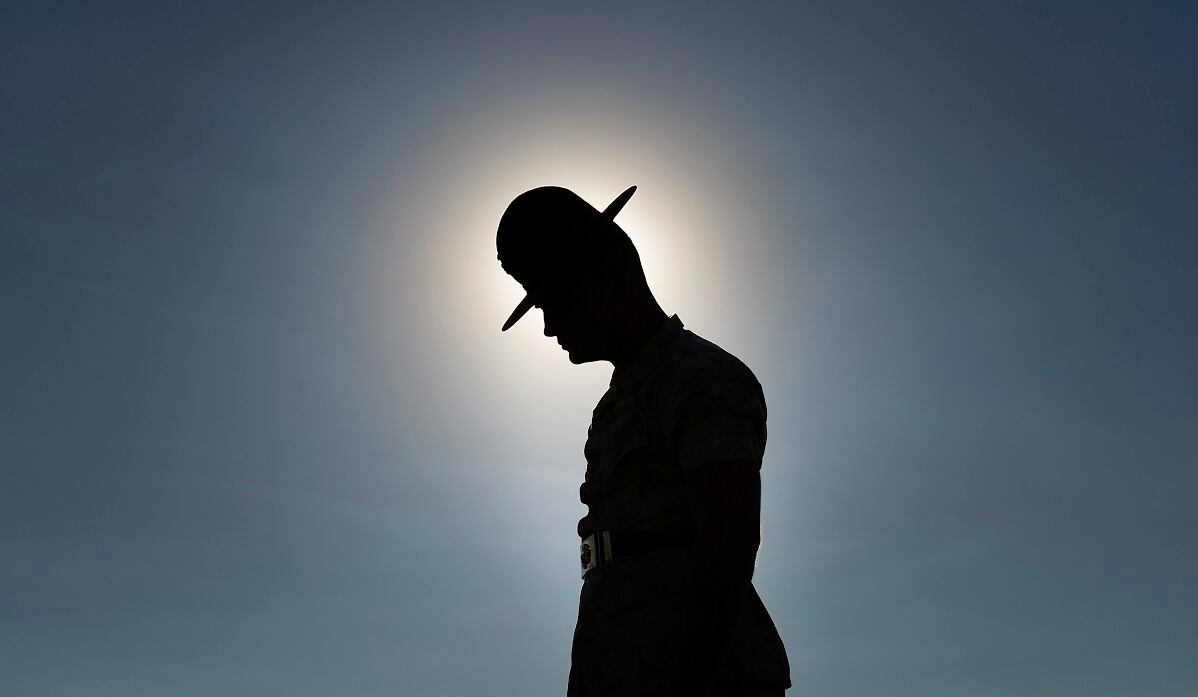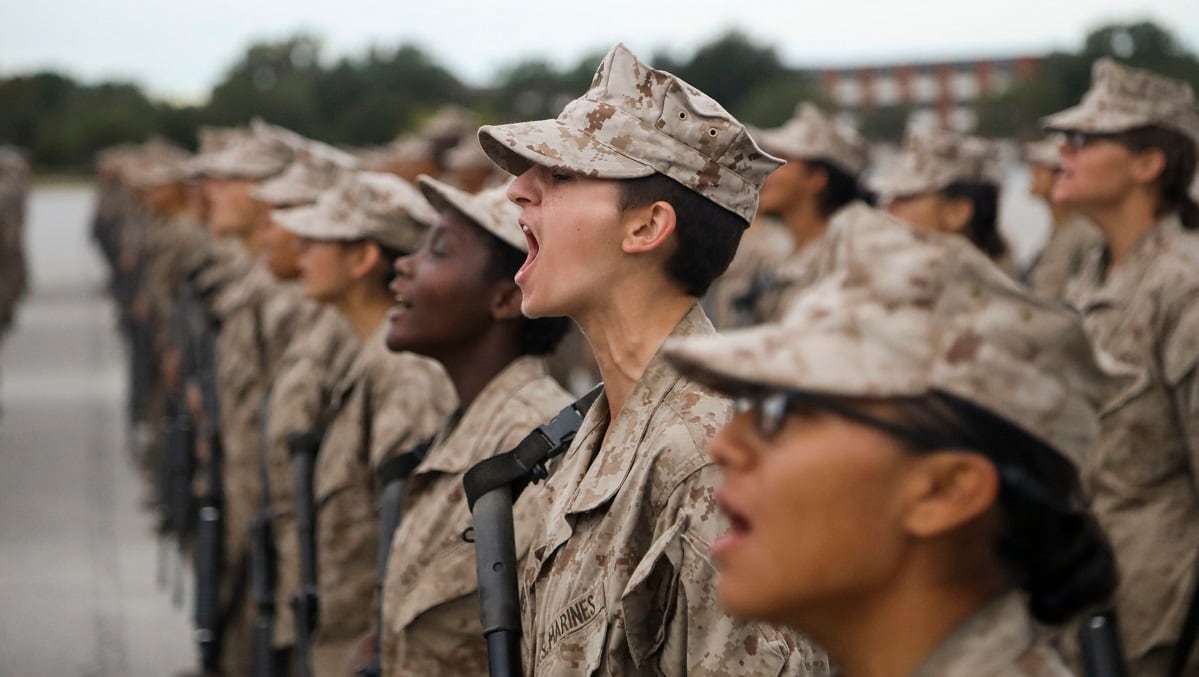A first-of-its kind study of Marine Corps boot camp shows different patterns in musculoskeletal injury rates and training progression for male and female troops. It also suggests possible training changes that might improve outcomes and lower drop rates.
Marine Corps leaders, however, say they’re still considering a way forward as they absorb study results.
The 739-page study, led by University of Pittsburgh’s Warrior Human Performance Research Center, was commissioned by the Marine Corps in a $2 million contract in 2020.
The Marine Corps was responding to a new congressional mandate to adopt a gender-integrated training model at both of its recruit depots, and the study largely focuses on interviews with recruits, new Marines and drill instructors.
A vast trove of biometric data, however, collected from Polar Grit X watches, saliva samples and thorough tracking logs, provides unprecedented insights into the physical experience of recruits in the 13-week boot camp training cycle.
The data also suggests fitness and training differences between male and female units that may lead to disparate outcomes.
RELATED

Researchers collected injury data from Marine Corps Recruit Depot Parris Island, South Carolina, for a gender-integrated company, made of female and male platoons training together, and a series track consisting of male and female-only companies.
Data from a male-only recruit company was collected from Marine Corps Recruit Depot San Diego, which had no female recruits until 2021.
Between male and female recruits, certain differences were dramatic.
Among the 98 female recruits in the series track, nearly 60% sustained at least one injury during training. Among the 95 male recruits, the injury rate was only about 30%.
In the integrated company cohort, the injury rate was lower across the board: about 25% for the 85 women, and 13% for the 106 men.
The male-only company had a reported injury rate of about 14%.
While lower body injuries were most common for male and female recruits by a substantial margin, women in both cohorts reported a higher rate of upper-body and torso injuries.
For female recruits in the integrated company, about half of injuries were in the torso, compared to 12.5% for males. Across the board, the most frequently injured body part for women was the hip, and for men, the knee.
One data point suggests just how much injury rates can be influenced by factors not fully captured by the research team, from fitness prior to boot camp to how a particular series training evolution was conducted.
For women in the series track, 23 injuries ― about a quarter of the boot camp total ― were sustained during various parts of the intense concluding exercise known as “the Crucible.” For female recruits in the integrated company, zero injuries were sustained during the Crucible.
For the study’s authors, the data shows that injury rates can be mitigated, and it’s up to the Marine Corps to develop ways to do that.
“Previous research has shown female military personnel who perform at the same levels of fitness as their male peers can be expected to experience similar levels of injury,” they wrote. “Further investigation of the risk factors for and strategies for prevention of musculoskeletal injuries among female Marine Corps recruits is recommended.”
Stress levels
The fitness tracker data and assessments of recruits’ cortisol, or stress, levels through saliva collection underscored boot camp’s intensity.
On average, all recruits covered about 14 kilometers, or nine miles, per day and burned 4,000 calories. They logged an average of six hours of sleep per night.
Stress levels for both men and women were high over the course of boot camp in all cohorts, and stayed elevated, even when training load was decreased.
While female recruits experienced higher cortisol levels than male counterparts, the study’s authors said that difference may be explained by some women’s use of oral contraceptives, which affect stress response.
For the study, recruits were subjected to a series of performance tests at week two and week 11 of boot camp to show their capacity for power and force. These included a countermovement jump, or jumping “as high and as fast as possible” for three reps; and an isometric mid-thigh pull, where recruits pulled with all their strength on a special steel apparatus for two five-second reps.
While peak force remained relatively consistent for all groups from week two to week 11, every group performed worse on peak power performance in the second test. Researchers attributed this to muscle fatigue and exhaustion; week 11 data was collected about a day after recruits finished the Crucible.
While men outperformed women in force and power at levels consistent with known physiological parameters, researchers found gender disparities might have been made more pronounced due to a workload progression not designed for resilience.
“As the Marine Corps considers options for optimizing gender integration, recruit performance and injury data from this study suggest an opportunity to revise the training structure to be more scientifically and physiologically sound to enhance performance, reduce injury, and improve retention during the training process,” the study’s authors wrote. “This can be done without sacrificing the desired stress placed on the recruit to make Marines, as demonstrated by the maintained stress response throughout training, even when training load was reduced. Instead, proper progression would likely mitigate injury to otherwise very capable recruits.”
A focus on proper exercise progression, “often absent” in training, according to the study, would improve outcomes for both female and male recruits, the authors found.
And, they said, it would also result in healthier and more effective Marines in the fleet.
“The return on investment would also improve during new Marines’ successful transition to the next phase of their military career after recruit training,” they wrote. “When considered in the context of the sociological findings, there appears to be an achievable and effective path forward to enhance the climate of success the Marine Corps has established over its existence.”
In the series track, female recruits dropped out of training at a lower rate, 13.3%, than their male counterparts, 21.1%. In the integrated company, the rate was slightly higher, 30.6% to 22.6%. The male-only cohort had a drop rate of 10.5%.
Attrition, or involuntary training drops, were less common for women in both cohorts: 2% for female recruits in the series track compared to 5.3% of men, and 3.5% in the integrated company compared to 8.5% of men. In the male-only cohort, 5.5% of recruits attrited.
Researchers noted that women who attrited reported a “significantly lower quantity of baseline strength training physical activity” prior to boot camp, a finding that indicated a strength training program prior to shipping may lower attrition rates.
The study recommended a periodized approach to physical training with a greater emphasis on progression and proper technique, and further investigation of the association between strength training and resilience scores in female recruits and their attrition rates.
It also called for a probe into the causes of hip injuries in female recruits and the development of customized injury mitigation programs.
The commander of Marine Corps Training and Education Command, Lt. Gen. Kevin Iiams, told Marine Corps Times in a late September interview that the Corps already has taken steps to space out boot camp training hikes and seen recruit attrition decrease as a result.
Col. Howard “Chip” Hall, the chief of staff at Training and Education Command and the Marine Corps’ liaison for the study, said the service’s Human Performance Branch was now closely examining its findings and determining what training adjustments could be standardized.
Marine leaders want to keep monitoring performance metrics through wearable tech and other measures, and Hall said they’re especially concerned about making sure the recruit training experience remains standard across the board ― although the existence of the different cohorts and their disparate outcomes shows that training is far from standardized now.
It’s now yet clear which study recommendations the Marine Corps might adopt or when it may do so.
“Our plates are pretty full,” Iiams said. “So there’s not a timeline, but we’re moving as fast as we can.”





